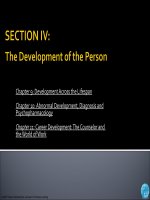The world of the Counselor An introduction to the counseling profession 5e chapter 4
Bạn đang xem bản rút gọn của tài liệu. Xem và tải ngay bản đầy đủ của tài liệu tại đây (1.33 MB, 36 trang )
Chapter 4: Individual Approaches to Counseling
Chapter 5: Counseling Skills
© 2007 Thomson Brooks/Cole, a division of Thomson Learning
1
Individual Approaches to Counseling
© 2007 Thomson Brooks/Cole, a division of Thomson Learning
2
Offers us a framework
Knowledge builds on knowledge (Paradigm Shifts)
See Box 4.1, p. 102
Theories are heuristic
Based on our view of human nature
Helps us work in an organized manner
Today, hundreds of counseling theories, but only some have
gained prominence
© 2007 Thomson Brooks/Cole, a division of Thomson Learning
3
Psychodynamic Approaches
Existential-Humanistic Approaches
Cognitive-Behavioral Approaches
Post-Modern Approaches
© 2007 Thomson Brooks/Cole, a division of Thomson Learning
4
Overview
Dominated early part of 20th century
Common elements
▪ Unconscious and conscious affects person’s functioning
▪ Early child-rearing has some affect on development of
personality
▪ Past, in interaction with conscious and unconscious, affects
person’s development
▪ Have tended to be longer term
Some approaches: psychoanalysis (Freud), analytical therapy
(Jung), individual psychology (Adlerian)
© 2007 Thomson Brooks/Cole, a division of Thomson Learning
5
Developed by Sigmund Freud
First comprehensive approach to therapy
▪ Psychic energy (instincts) drive behavior
▪ Life instinct (Eros): love, intimacy, sex, survival
▪ Death instinct (Thanatos): fear, hate, self-destructive
behavior aggression
▪ All life and death instincts = libido
Structure of personality:
▪ Id (pleasure principle)
▪ Ego (reality principle)
▪ Superego (moral imperatives)
© 2007 Thomson Brooks/Cole, a division of Thomson Learning
6
Psychosexual Stages: Oral, Anal, Phallic, Latency, Genital
Parenting affects developmental through stages
Defense mechanisms reflect that development
Name some defense mechanisms!
Deterministic Approach
See Figure 4.1, p. 104
Long term approach that relies on making a little more of the
unconscious conscious
© 2007 Thomson Brooks/Cole, a division of Thomson Learning
7
Techniques
Free Association
Dream Analysis
Empathy
Developing transference
relationship
© 2007 Thomson Brooks/Cole, a division of Thomson Learning
Techniques
Interpretation of:
▪ Resistance
▪ Defense mechanisms
▪ Parapraxes
▪ Dreams (manifest and
latent meanings)
▪ Transference
8
Developed by Carl Jung
Less pessimistic and less deterministic than Freud
8 Psychological Types—include combinations of:
▪ Extraversion and Introversion (E or I) with
▪ Mental Functions: Thinking and Feeling (T or F); Sensing and
Intuiting (S or N)
Information that matches psychological type goes into
consciousness. Information that doesn’t, goes into personal
unconscious.
Our collective unconscious is inherited. Contains archetypes —
tendency to perceive things in ways we call “human”
Well known archetypes: persona, anima and animus, shadow
© 2007 Thomson Brooks/Cole, a division of Thomson Learning
9
Jung believed we can make almost anything conscious
If we understand our personal and collective unconscious, we
are “whole”
Techniques:
Goal of techniques—to make unconscious conscious
Some techniques:
▪ Examining our dreams
▪ Meaning of symbols
▪ Creative Techniques (working with clay)
▪ Active imagination
© 2007 Thomson Brooks/Cole, a division of Thomson Learning
10
Developed by Alfred Adler
“Teleology”—we inherently are goal directed
We move to fulfill one drive—striving for perfection.
All other drives subsumed by this one
Part of being human: having feelings of inferiority
Feelings of inferiority lead us to our subjective final goal
Our private logic leads us toward our final goal
Drive toward our subjective goal results in development of
behaviors that compensate for feelings of inferiority
You can tell how a person is driven toward his/her goal through
his/her style of life
© 2007 Thomson Brooks/Cole, a division of Thomson Learning
11
Work through feelings of inferiority, and you will move toward
social interest (Gemeinschaftsgefuhl)
Followers: Dreikrus and Dinkmeyer
Worked with children whose typical behaviors from feelings
of inferiority yield:
▪ Attention seeking, use of power, revenge seeking, and
inadequacy
Sometimes seen as an early humanistic approach (through
education and counseling one can change)
One of first approaches to work with families
© 2007 Thomson Brooks/Cole, a division of Thomson Learning
12
Phase of therapy
Building relationship
Assessing lifestyle
Insight and
interpretation
Reeducation and
reorientation
Techniques:
Exploring family constellation
Examining early recollections
Encouragement
Democratically held discussion groups
Limit setting
Acting “as if” spitting in client’s soup
Setting logical and natural
consequences
© 2007 Thomson Brooks/Cole, a division of Thomson Learning
13
Overview
Loosely based on existential philosophy
Deals with struggles of living and how we construct
meaning in our lives
Tends to be optimistic and not deterministic
Phenomenological perspective
Focus on consciousness and the relationship
Help people “self-actualize”
Three approaches: Existential Therapy, Person-Centered,
Gestalt Therapy
© 2007 Thomson Brooks/Cole, a division of Thomson Learning
14
A number of theorists developed this approach: Frankl
(Logotherapy); May, Bugental, Yalom
Central tenets of most existential approaches
▪ Born into a world with no inherent meaning
▪ We make our meaning
▪ Struggle throughout life to be “human”
▪ Most people live a life of limited self-reflecton
▪ We are born alone, die alone, and mostly live alone
▪ Choice about who we are
▪ Can gain awareness about choices we made
▪ See Box 4.4, p. 110
© 2007 Thomson Brooks/Cole, a division of Thomson Learning
15
Developed by Carl Rogers (“client-centered therapy”)
We all have need to be regarded
Conditions of worth placed on us by significant others
Help people become more congruent and gain a more
realistic sense of ideal self
"Necessary & sufficient conditions" (pp. 110-111)
“Techniques”:
▪ Congruence/genuineness
▪ Unconditional positive regard
▪ Empathic understanding
See Box 4.5, p. 111
© 2007 Thomson Brooks/Cole, a division of Thomson Learning
16
Developed by Fritz Perls
Based on Gestalt psychology, phenomenology, &
existentialism
More directive
Self-regulation, need identification, and need-fulfillment
Only aware of needs in “foreground”
“Blockages” or “impasses” yield “unfinished business”
Now = experience = awareness = reality
Anti-deterministic
Techniques “push” one into awareness (pp. 114-115)
© 2007 Thomson Brooks/Cole, a division of Thomson Learning
17
Overview
Pavlov (1848-1936): Classical Conditioning
Skinner (1904-1990): Operant Conditioning
Bandura: Modeling or Social Learning (1940s)
Recent Years:
▪ Cognitive Structures
▪ illogical Ways of Thinking
See common assumptions (p. 116)
Approaches: Modern-Day Behavior Therapy, Rational
Emotive Behavior Therapy, Cognitive Therapy, Reality
Therapy and Choice Theory
© 2007 Thomson Brooks/Cole, a division of Thomson Learning
18
Developed by Many Different Indivdiuals
Based on an understanding of classical condition,
modeling, and operant conditioning
Therapeutic stages
1. Building the relationship
2. Clinical Assessment
3. Focusing on Problem Areas and Setting Goals
4. Choosing Techniques and Working on Goals
5. Assessment of Goal Completion
6. Closure and follow-up
Some techniques: See Box 4.8
© 2007 Thomson Brooks/Cole, a division of Thomson Learning
19
REBT: Developed by Albert Ellis
Complex interaction between thinking, feeling, & acting
Mostly, focus on Rational vs. Irrational Thinking
People have cognitive distortions
People often driven by 1 or more of 3 core irrational beliefs
(see Box 4.9, p. 120)
ABCs of feeling and behaving
Relationship important, but not critical (see Box 4.10, p. 120)
© 2007 Thomson Brooks/Cole, a division of Thomson Learning
20
Developed by Aaron Beck
Continuity hypothesis: older emotional responses continue
into modern day world
Diathesis-stress model: biological/genetic/environmental
model—under stress, our (unique) disorders are shown
Rational, pragmatic, antideterministic, educative, empirical
We all have “core beliefs” that drive us—embedded beliefs
often out of our awareness
We can have negative core beliefs (see Box 4.11)
© 2007 Thomson Brooks/Cole, a division of Thomson Learning
21
Cognitive Therapy (cont’d)
Core beliefs lead to intermediate beliefs (“attitudes, rules,
and expectations”)
Intermediate beliefs lead to automatic thoughts
Automatic thoughts related to certain “cognitive
distortions (see Table 4.1, p. 123)
Automatic thoughts lead to possible reactions to certain
situations (see Figure 4.2, p. 124)
Treatment: focus on automatic thoughts, get to
intermediate beliefs, then get to core beliefs—change core
beliefs through thinking and acting differently
© 2007 Thomson Brooks/Cole, a division of Thomson Learning
22
Developed by Glasser—originally called Reality Therapy
Five genetically based needs: survival, love and belonging,
power, freedom, and fun
Unique “need-strength profile”
We can only satisfy our needs and control our behaviors in
the present
Since birth, we create a “quality world” to determine how
to satisfy our needs
Some quality worlds lead to destructive behaviors
© 2007 Thomson Brooks/Cole, a division of Thomson Learning
23
Reality Therapy (cont’d)
▪ Can change the pictures in our quality worlds and our
behaviors
▪ Total behavior: We can only choose our actions and
thoughts
▪ Use internal-control language, not external control
language
▪ Techniques: see WDEP system (Figure 4.3, p. 127)
▪ Anti-deterministic
© 2007 Thomson Brooks/Cole, a division of Thomson Learning
24
Overview
Based on post-modernism, social constructionism, poststructuralism
▪ Post-modernists: Questions modernism and many
assumptions and beliefs we take for granted
▪ Social Constructionism: Values are transmitted through
language via social milieu (family, culture, society)
▪ Post-structuralism: Questioning of “inherent truths” or
“structures” we have believed
Two approaches: Narrative Therapy and Solution-Focused
Brief Therapy
© 2007 Thomson Brooks/Cole, a division of Thomson Learning
25









